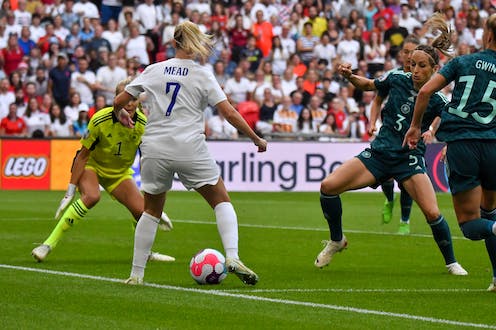Women’s football is riding high. Not only are fans celebrating the success of the England team at the Arnold Clark Cup and Euro 2022, but this year will see the Fifa Women’s World Cup kick off in July.
The popularity of the women’s game has led to more girls than ever before playing the sport. But alongside this has been a rise in knee injuries, in particular to the anterior cruciate ligament (ACL) in female players.
The ACL is a ligament in the knee that provides stability. If injured the knee can be susceptible to giving way, especially during sports. This injury often requires surgery and prolonged periods of rehabilitation. Even then, not all will return to the same level of play, so it’s an especially devastating injury for athletes.
A spate of high profile ACL injuries in women’s football including Beth Mead, awarded BBC Sports Personality of the Year, Alexia Putellas winner of the international football award the Ballon d’Or – along with 25% of the 2022 nominees – has resulted in calls for further research to understand the factors associated with ACL injury and the disparity in injury rates between men and women.
What we know so far
It has long been known that females are around three times more likely to suffer ACL injury compared with men. One study estimates that a female athlete has a one in twenty chance of an ACL injury every year, but it’s still not clear exactly why.
While some ACL injuries come from direct contact with an opponent, most are non-contact resulting from sudden deceleration, jump landings or changing direction. So many sports including basketball, netball and rugby also pose a high risk of ACL injury.

Pepermpron/Shutterstock
In football, defending is a particular risk as it involves unanticipated or reactive positions. And increased training and game time among professional women footballers over recent years has resulted in more exposure to these high-risk situations.
It has also been suggested that fatigue could increase the risk of ACL injury – with tired muscles less able to absorb shock and control movements. But while this link seems logical, ACL injuries do not occur more frequently later in a game or the season, which you would expect if it was down to fatigued muscles. So could it be down to differences in anatomy between men and women?
Anatomical differences
Females have a wider pelvis relative to leg length, which results in increased angulation at the knee. The shape of the bones is also different in women in that the ACL passes through a narrower space to attach to the thigh bone, which may make it more susceptible to injury. The actual size of the ACL is also often smaller in females, so may be less able to withstand high forces.
In general, females have looser knee ligaments, which has been shown to increase the risk of injury. It’s thought that having looser knee ligaments can diminish joint proprioception – this is a sense of movement and position which is essential to perform movement tasks safely.
It has also been suggested that women may be more prone to ACL injury at certain times in their menstrual cycle. This is because changing hormones, especially when oestrogen levels are at their highest (around day 12 in a 28-day cycle), can increase the looseness of joints (hypermobility).
While some research shows that oral contraceptives may help to reduce this risk, more recent evidence suggests that the pill has no protective effect.
Studies also show that women have delays in the activation of hamstrings tend to overuse their quadriceps when landing from a jump, which increases the force on the ACL.
Reduced strength in the trunk (core) muscles and the hip have also been shown to predict knee injury in females. Research has also found that women tend to land on a knee that twists or buckles inwards, which is commonly seen in ACL injuries.
What can be done?
There’s no doubt that the increased rate of ACL injury in females isn’t down to any one thing. Indeed, research from 2021 also shows that social and gender roles in sport may increase the risk of ACL injury in females – with women’s football (at both professional and grassroots level) still receiving less funding and expertise compared with the men’s game.
Though there is good evidence that improvements can be made through specific training programmes. It has even been suggested that all female athletes, especially those under 18, should use these programmes to help reduce the risk of serious injury.
One study, for example, found that by doing a series of specific exercises, female athletes could reduce their risk of ACL injury by 50% – with a 67% reduction for non-contact ACL injuries.
Although the research indicates that such interventions may be more effective in younger players than professional athletes, these programmes do seem to work and are easy to implement, making them cost-effective with little risk.
At the moment, prevention programmes are the most powerful tool we have to reduce injury. So they should be promoted widely and implemented at an early age in all high-risk sports to help stem the catastrophic epidemic of female ACL injuries.
![]()
The authors do not work for, consult, own shares in or receive funding from any company or organisation that would benefit from this article, and have disclosed no relevant affiliations beyond their academic appointment.











